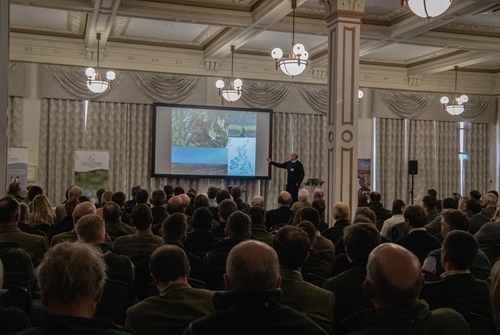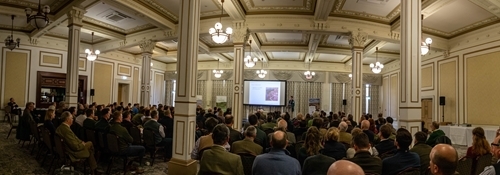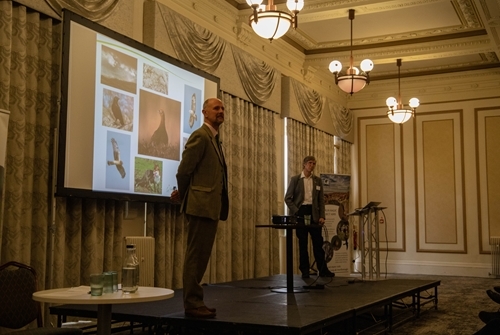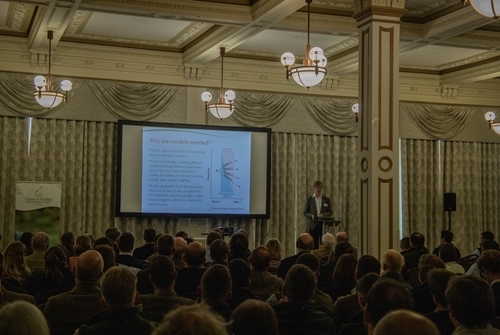Written by Hazel Sarti, English Uplands Placement Student

On February 28th, the Game & Wildlife Conservation Trust’s Upland Research Team hosted the North of England Grouse Seminar at the Cedar Court Hotel in Harrogate. The bi-annual conference was attended by almost 200 people with an interest in grouse. Presenters included three of my colleagues in the Trust’s Upland Team, a professor from the University of Birmingham and an ornithologist from Natural England. Their presentations explored recent research on contentious topics associated with moorland management. If you were fortunate enough to attend, you would have seen me manning the reception, sifting through the pile of name badges, and sneaking in bites of pastries between the waves of arriving delegates.
As one of this year’s Uplands placement students, I have been exposed to the beauty and diversity of heather-dominated upland landscapes while becoming immersed in the often-complex task of moorland management through my involvement with the Trust’s research. The conference provided a useful occasion for stakeholders, many of whom host the Team’s studies, to convene and share ideas, while also providing valued feedback on research outcomes.
Nick, The Marquess of Downshire, launched the seminar with a warm welcome noting with relief how recent years’ of Covid-related turmoil had made it a rare sight to observe so many delegates within the same room. Addressing the attendees within the vibrant sea of tweed, many of whom I’m certain he recognised due to his extensive involvement with the GWCT and Moorland Association, Nick introduced the first speaker of the day, Dr David Baines.

Suitably commencing the seminar as the Trust’s Director of Upland Research, Dave presented a collation of the Team’s recent studies examining how predator control and heather burning on grouse moors, helped to sustain higher wader abundance and breeding success in comparison to unmanaged moors. Regardless, breeding wader populations are continuing to decline nationally. Hoping to identify specific predators associated with low breeding success, Dave presented initial results from trail cameras sited at curlew, lapwing, and oystercatcher nests. The project will continue this year and involve more cameras at more nests. For more information on the Otterburn experiment, which Dave used extensively in his presentation, follow the link here.
Dr Philip Warren provided an update on the 18-month Merlin Magic Project funded through Defra’s Green Recovery Challenge Fund. Since being red-listed in 2015, Merlin have continued to decline. Analysis of nest site selection by the project indicated that tall heather was not limiting nest site availability, whilst counts of pipits and larks indicated that avian prey availability was not limiting either breeding distribution or chick survival, the latter being high across the chosen study areas. Instead, it appeared that over-winter survival, especially amongst juveniles may be the cause of Merlin declines. Phil repeated Dave Baines’ message that grouse moors are providing refuges for nationally declining species, in this case the merlin. To learn more about Merlin and view nest camera footage, click here.
After a short coffee break, Dr Nicholas Aebischer, the Trust’s biostatistician, discussed his application of adaptive management methods to reconsider 28 years of ecological data collected from Langholm Moor that can be used to help interpret causes of changes in red grouse abundance. By comparing a suite of factors including habitat, weather, grouse parasites, controlled predators, and non-controlled predators such as buzzard and hen harrier abundance in various combinations, the models were able to accurately predict changes in red grouse abundance in subsequent years at Langholm. This project demonstrated how statistical modelling, when used in conjunction with large volumes of data, can be used to highlight variables that best explain outcomes. View a summary of the study here.

Following on from Nicholas’ presentation, Stephen Murphy, an ornithologist specialising in Hen Harriers for Natural England, described the recent increase in numbers of hen harriers nesting in northern England. Often a controversial topic, Stephen emphasised the importance of grouse moor managers who help to maintain suitable habitat for hen harriers and reduce predation risk through management for red grouse. By working closely with land managers to understand their concerns, Stephen is working to find a bridge between maintaining a healthy population of hen harriers that can coexist with the retention of driven grouse shooting.
After a well-earned lunch break, Professor Nick Kettridge from the University of Birmingham outlined two Natural Environment Research Council funded projects with the aim of creating a UK-specific Fire Danger Rating System (FDRS). Considering the serious wildfire risk associated with increasing summer temperatures, this research is particularly relevant, especially in areas of unmanaged heather moorland. The FDRS will assess the vulnerability of a site to wildfire based on its socioeconomic and ecological value as well as ignition susceptibility and the subsequent wildfire behaviour based on weather conditions and fuel flammability. Nick concluded his talk by asking for participants who would be willing to share their ideas on managing landscapes for wildfire and discuss how landscape management techniques influence fire behaviour.
Opportunely following on from Nick, Dr Siân Whitehead of the Trust’s Uplands Team discussed her ongoing experiment that explores how heather burning and cutting influence hydrology, subsequent vegetation restoration, and invertebrate abundance. While only in its third of a predicted 10 years of post-treatment monitoring, to date it has clearly shown how all sites are different in their responses to management. Data collection in further years will help distinguish effects of treatment from seasonal and site effects. Siân also described a new experiment which will examine how cut height of heather stands influences vegetation regrowth, hydrology, brash decomposition, and nutritional value of heather and brash. Click here to explore Siân’s work on heather cutting and Sphagnum mosses.

To conclude the day, and keep the audience on their toes, the seminar continued with brief updates relating to ongoing GWCT research. Reporting on how pre-breeding condition of hen red grouse influences their breeding success, Dave returned to the podium and evidenced how hen condition is most significantly determined by the nitrogen content of cotton grass. Clutch size and egg volume are also influenced by food quality but are further determined by the availability of cotton grass, as well as the intensity of strongyle worm parasites.
Dr Phil Warren reported some possible new directions for black grouse, including the initiation of a new study which aims to identify factors contributing to suitable brood habitat and how these conditions can be replicated to improve breeding success. These data will also be used to inform selection of suitable habitat for the potential range expansion of black grouse into the North York Moors and Cheviots.
Lastly, Dr Siân Whitehead briefed the audience on her research into heather recovery following attacks by heather beetle. While only in the first few years of post-management data collection, recovery appears to be quickest on stands that have received no management intervention in comparison to the burn and cut treatments. However, it must be noted that since the beetle outbreaks, weather has been near optimal for general heather recovery.
Thanking everyone for their attendance, the Marquess returned to the podium to emphasise the vital role estates play by hosting research conducted by the Trust. He and the Trust’s Director of Fundraising Jeremy Payne appealed for greater financial support from those attending, including the pledging of grouse shooting days as auction lots, where no offers of days were made in 2022. He further emphasised how integral the GWCT’s Upland Team’s research was to the advancement of scientific understanding of moorland processes while also informing policies that continue to prioritise the health of upland ecosystems.